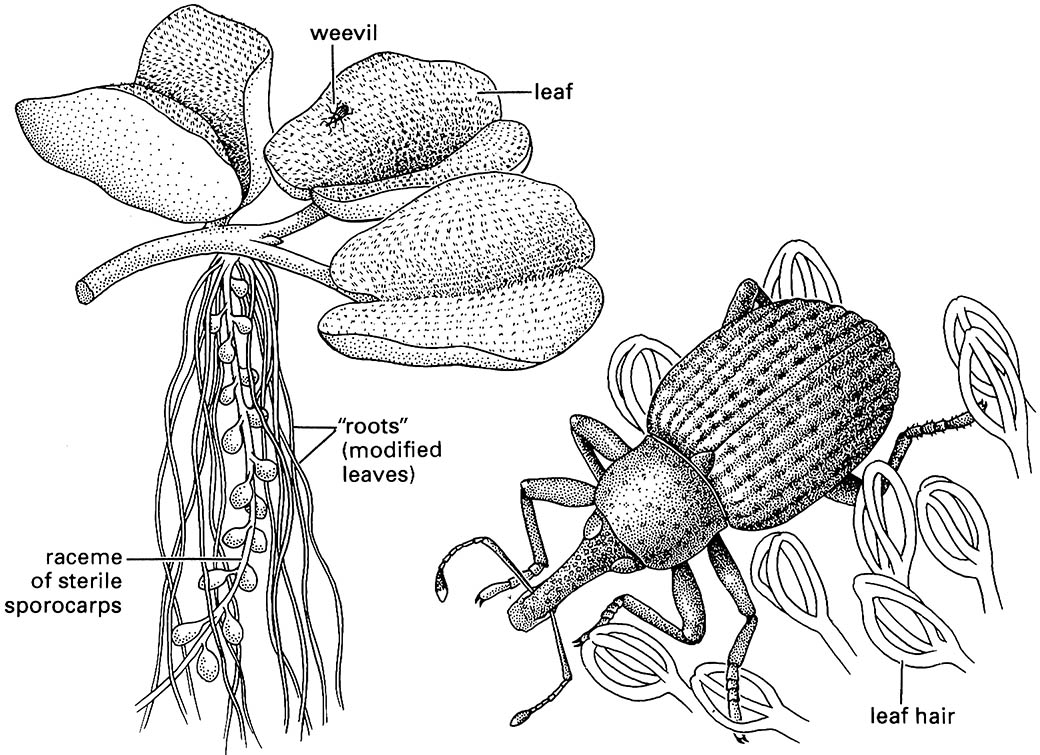Box 11.3. Salvinia and phytophagous weevils
The floating aquatic fern salvinia (Salviniaceae: Salvinia molesta) (illustrated here, after Sainty & Jacobs 1981) has spread by human agency since 1939 to many tropical and subtropical lakes, rivers, and canals throughout the world. Salvinia colonies consist of ramets (units of a clone) connected by horizontal branching rhizomes. Growth is favored by warm, nitrogen-rich water. Conditions suitable for vegetative propagation and the absence of natural enemies in its non-native range have allowed very rapid colonization of large expanses of freshwater. Salvinia becomes a serious weed because its thick mats completely block waterways, choking the flow and disrupting the livelihood of people who depend on them for transport, irrigation, and food (especially fish, rice, sago palms, etc.). This problem was especially acute in parts of Africa, India, south-east Asia, and Australasia, including the Sepik River in Papua New Guinea. Expensive manual and mechanical removal and herbicides could achieve limited control, but some 2000 km2 of water surface were covered by this invasive plant by the early 1980s. The potential of biological control was recognized in the 1960s, although it was slow to be used (for reasons outlined below) until the 1980s, when outstanding successes were achieved in most areas where biological control was attempted. Choked lakes and rivers became open water again.
The phytophagous insect responsible for this spectacular control of S. molesta is a tiny (2 mm long) weevil (Curculionidae) called Cyrtobagous salviniae (shown enlarged in the drawing on the right, after Calder & Sands 1985). Adult weevils feed on salvinia buds, whereas larvae tunnel through buds and rhizomes as well as feeding externally on roots. The weevils are host-specific, have a high searching efficiency for salvinia, and can live at high population densities without intraspecific interference stimulating emigration. These characteristics allow the weevils to control salvinia effectively.
Initially, biological control of salvinia failed because of unforeseen taxonomic problems with the weed and the weevil. Prior to 1972, the weed was thought to be Salvinia auriculata, which is a South American species fed upon by the weevil Cyrtobagous singularis. Even when the weed’s correct identity was established as Salvinia molesta, it was not until 1978 that its native range was discovered to be south-eastern Brazil. Weevils feeding there on S. molesta were believed to be conspecific with C. singularis feeding on S. auriculata. However, after preliminary testing and subsequent success in controlling S. molesta, the weevil was recognized as specific to S. molesta, new to science, and named as C. salviniae.
The benefits of control to people living in Africa, Asia, the Pacific, and other warm regions are substantial, whether measured in economic terms or as savings in human health and social systems. For example, villages in Papua New Guinea that were abandoned because of salvinia have been reoccupied. Similarly, the environmental benefits of eliminating salvinia infestations are great, as this weed is capable of reducing a complex aquatic ecosystem to a virtual monoculture. Now, control by this weevil is benefiting aquatic systems in the USA, especially the south-eastern states where S. molesta was introduced in the 1990s through the aquarium and landscape trades.
The economics of salvinia control have been studied only in Sri Lanka, where a cost—benefit analysis showed returns on investment of 53 : 1 in terms of cash and 1678 : 1 in terms of hours of labor. Appropriately, the team responsible for the ecological research that led to biological control of salvinia was recognized by the award of the UNESCO Science Prize in 1985. Taxonomists made essential contributions by establishing the true identities of the salvinias and the weevils.




